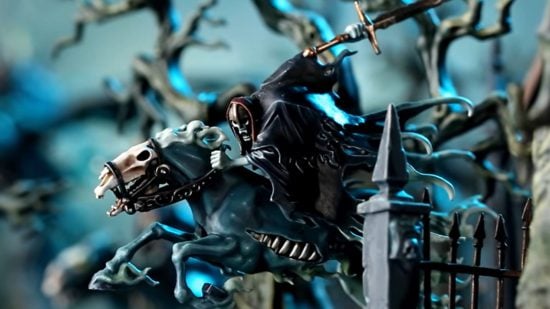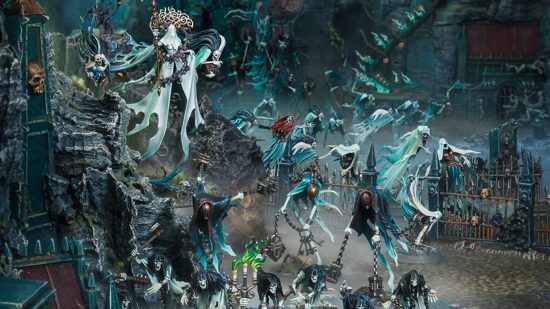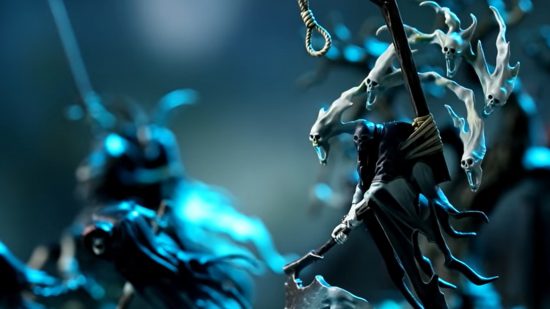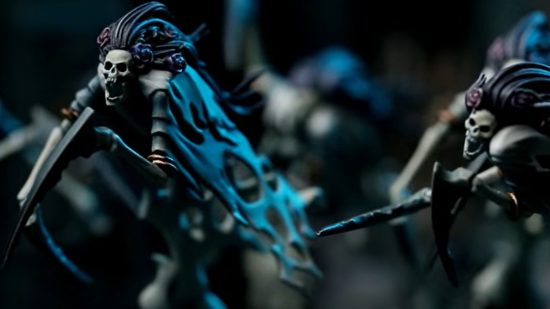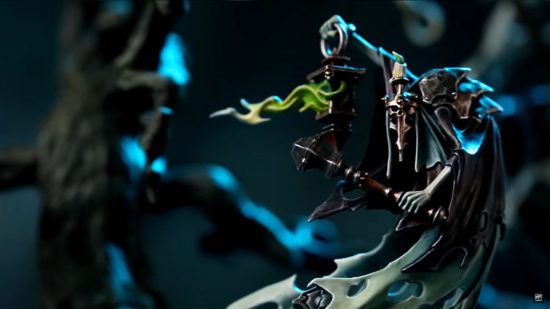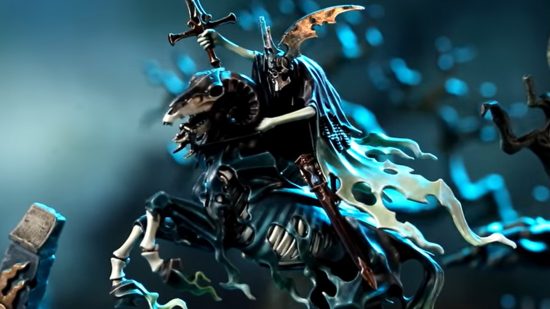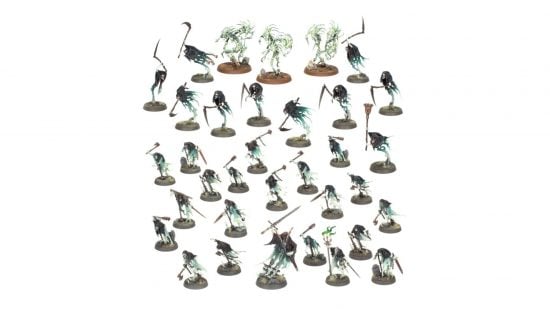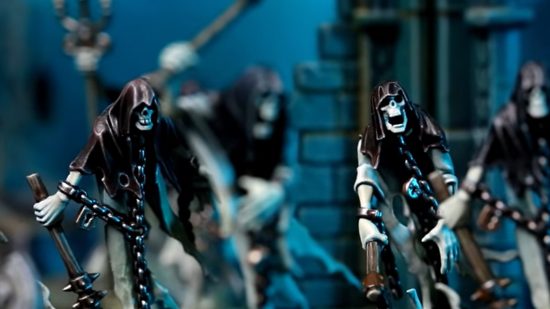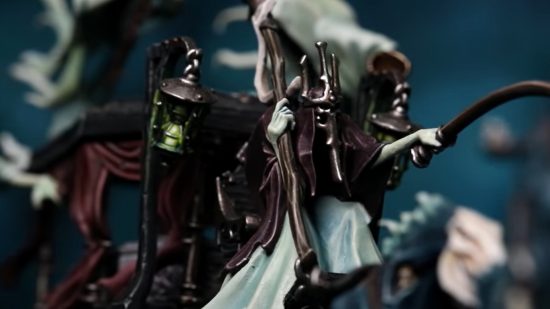The Warhammer Age of Sigmar Nighthaunt faction proves that two things never die: wrath, and wraiths. These aren’t your average undead spectres, but ghoulish manifestations of the sins that the dead once committed in life. Most of the Nighthaunt were deliberately created by the necromantic magic of Nagash, Lord of Undeath, who rallies processions of these tortured souls and sends them into battle to mete out punishment on his behalf.
Able to terrify, teleport, and return from the dead, the Nighthaunt are an Age of Sigmar army with a lot going on. Their swords and scythes can dole out some ghastly damage, but the Nighthaunt rely heavily on their heroes and spells to grasp victory. If you want to crack open the gilded Stormcast Eternals and claim the souls that are the rightful property of Nagash, you need to get a good grip on your ghoulies.
If you’d prefer your undead with a little more meat on the bone, check out our guide to the Soulblight Gravelords – or if that doesn’t sound like your cup of ectoplasm, we have a guide to all the Age of Sigmar armies to help you pick the one that’s right for you.
Nighthaunt battletome
The current Nighthaunt battletome was released in May 2022, and it’s up to date for the current, third edition of Warhammer: Age of Sigmar. It has full rules for all the models in the Nighthaunt range, as well as the spells, relics and command traits that Nighthaunt heroes can use, and the army-wide Battle Trait rules that your whole force will benefit from.
Enemy units within melee range of Nighthaunts are afflicted by their Aura of Dread, which prevents them from issuing or receiving the Inspiring Presence Command. This gives Nighthaunts a lot of attrition power, as this universal command ability would normally allow opponents to resist the effects of Battleshock.
As Ethereal ghosts, only partly present in the physical realm, Nighthaunt are hard to hurt and hard to pin in place. Their saves cannot be modified. That means they’ll always use their base save, no matter the Rend characteristic of enemy attacks. But it has a downside – there’s no point in Nighthaunt wizards casting Mystic Shield to try and buff up their saves. Nighthaunt also benefit from a 6+ ward save, which can be further buffed to a 5+ ward by receiving the Discorporate command.
With no solid physical form, Nighthaunt can retreat from combat and then charge in the same turn. They can all also fly, allowing them to move over terrain and models without hindrance. Their movement shenanigans can even begin before the first movement phase thanks to the Vanishing Phantasms rule. This allows you to remove three units from the battlefield at the end of deployment and put them into an ambush reserve, ready to enter play anywhere more than nine inches from all enemy units. They’re all also fast, most of them having a movement speed of eight inches or more.
When they do make combat, the Frightful Touch of the Nighthaunt is enough to stop the hearts of the bravest enemies. Whenever Nighthaunts make a to-hit roll of six, they automatically wound the target without making a wound roll. Nighthaunt charges are particularly dangerous. After completing a charge move with a Nighthaunt unit you’ll look up the unmodified charge roll on the Wave of Terror table, which will afflict your charge target with a debuff; that might reduce the target’s accuracy, or even apply the devastating Strike Last effect.
Nighthaunt processions
Nagash decides the fate of each Nighthaunt he summons, trapping them in an eternal torment that befits the wicked life they led. He also assembles different Nighthaunt processions according to his needs. You can choose one of these four subfactions for your Nighthaunt army.
The Grieving Legion
The Grieving Legion is populated by the ghosts of torturers and executioners who wish to continue their gruesome professions beyond the grave. This procession prefers to attack as a horde, and any enemy within three inches of ten or more Grieving Legion will find themselves unable to retreat.
The Emerald Host
The Emerald Host have been gathered to do the bidding of the Nighthaunt’s Mortarch, Lady Olynder. On her behalf they carry out the Emerald Curse and inflict terrible mortal wounds on the enemy. In practice, this means you can choose D3+1 enemy units on the battlefield, and you deal D3 mortal wounds to each of them at the end of each battle round if you roll a 2+ for that unit. This is particularly punishing for armies with high armour saves and no Ward saves – Kharadron Overlords, we’re looking at you.
The Scarlet Doom
The Scarlet Doom’s troops all met their end in particularly traumatic fashions, and revenge drives them to charge the enemy with rage-filled vigour. Bladegheist Revenants from this procession are frenzied attackers – after a unit has charged, you can roll a die for each of its models, and inflict a mortal wound on the target for each roll of 5+.
The Quicksilver Dead
Finally, there’s the Quicksilver Dead. Your bread and butter here are the Dreadscythe Harridans, healers who robbed Nagash of souls and now kill and maim in his name. Ward rolls can’t be made for wounds caused by any melee attack they make.
Nighthaunt heroes
The Nighthaunt have access to a wide array of powerful support characters, each of which brings useful buffs to your army. Though competent spellcasters and melee combatants, for the most part their role is to provide area buffs to your allies and debuffs to your enemies.
Guardian of Souls
The Guardian of Souls is a wizard, able to cast and dispel one spell each battle round, with the ever-useful Spectral Lure spell that allows them to heal wounds or return slain models to friendly units. More importantly, their Nightmare Lantern adds 1 to wound rolls for melee attacks by friendly Nighthaunt units wholly within 12”, a massive range for this powerful combat buff.
Knight of Shrouds
The Knight of Shrouds is a fairly effective melee fighter, who makes five life-stealing attacks with the Sword of Stolen Hours, but again their main use is as a force multiplier. Their Spectral Overseer ability allows them to issue the Redeploy or Unleash Hell universal commands once per battle round without using a command point, two reactive commands that will help you to blunt enemy charges.
Knight of Shrouds on Ethereal Steed
The mounted Knight of Shrouds on Ethereal Steed has the similar Lord of Gheists ability, which lets them freely use the much more aggressive All-out Attack command. Both versions of the Knight want to be in the front of the battleline – the first time each is selected to pile in and attack during the combat phase they can bring a whole unit of Nighthaunt infantry with them.
Lady Olynder, Mortarch of Grief
Lady Olynder is the most powerful Nighthaunt special character, and one of Nagash’s most powerful generals. In life, Olynder was a schemer and liar. Manipulating her way to the royal court of her kingdom, she murdered her husband-to-be and claimed his empty throne. She wore a veil of feigned grief for the rest of her mortal life.
Nagash is fond of ironic punishments, and in death he afflicted her with grief beyond all mortal reckoning. In the upheaval caused by the Necroquake that marked the start of Age of Sigmar second edition, Nagash recognised Olynder’s that the scheming mind and hunger for power she had exhibited in life would serve him well as a general. He knighted Olynder one of his Mortarchs, granting her a fraction of his divine essence.
Olynder is a dangerous mage, able to cast and unbind two spells per battle round, and wields the Staff of Midnight, a melee weapon with a respectable Rend of -2 and two damage. But, as with lesser Nighthaunt commanders, her main use is as a force multiplier.
Her status as Mortarch of Grief allows her to cancel out any commands issued within 12” of her on a roll of 5+. Once per battle she can declare that there is No rest for the Wicked, and return d6 slain models to every Nighthaunt Summonable unit on the table. Lifting the Veil that covers Olynders regal features will inflict up to six mortal wounds on an enemy unit within 12”, potentially healing her Olynder if she successfully kills an enemy. Lastly, her signature spell Grief-stricken is a devastating debuff on a single enemy unit, subtracting one from hit rolls that they make and adding one to hit rolls that target them.
Nighthaunt Vanguard box
The easiest starting point for any Age of Sigmar army is the Vanguard box set. The Nighthaunt box set contains:
- Chainrasps x 20
- Grimghast reapers x 10
- Spirit Hosts x 3
- Knight of Shrouds
Chainrasps are a cheap, fast-moving unit. They have a weak 5+ save, and each model has two mediocre attacks. Nevertheless, you’ll make a lot of attacks, which increases your odds of triggering Frightful touch. With an 8” move you have a good chance of charging your enemy, giving you them a debuff from the Wave of Terror table, and the Chainrasps +1 to wound from their in-built Chilling Horde ability.
Grimghast Reapers are just as fast, and carry Slasher Scythes, which have an wound on a 3+ and a handy Rend of -1. Enemies in units with five or more models risk being Reaped like Corn by the Grimghast, who get an extra attack when they target enemy hordes.
Spirit Hosts are floating clouds of ectoplasmic energy. Their attack stats aren’t impressive, but there’s a different reason they are Drawn to War: as long as they are within 3” of a friendly Hero, they can intercept any wounds or mortal wounds that Hero would suffer on a 3+.
All three infantry units in this box are battleline choices, making this a very strong foundation for any army. To expand this into an army, you could consider Craventhrone Guard, crossbow toting ghouls who can target enemies they can’t even see with their ethereal bolts, and who will benefit from the Knight of Shrouds’ Spectral Overseer ability.
Nighthaunt Scriptor Mortis
If all of this sounds too orderly for you, pick up the Scriptor Mortis instead. This is an extremely random but powerful character slayer, who can pick an enemy hero to be Sentenced to Eternal Torment, penning their name in its giant notebook during the Hero phase. In subsequent Hero phases or at the end of the game, as long as the Scriptor and its target are on the table still, you’ll roll a d6 – roll less than the current battle round number and the target will suffer 2d6 mortal wounds. It’s not an ability that you can rely on whatsoever – but your opponent has to deal with your malevolent pen-pusher, or risk losing a hero to a single stroke of the quill.
Nighthaunt paint scheme
Nighthaunt can be the simplest Age of Sigmar army to paint, so they’re a great way to get started painting miniatures – you can paint every part of their models in the same, phantasmal hue, from cloaks to weapons to ornamental headgear. Games Workshop make this easy with their Contrast paint range. Basecoat your models with a white or off-white primer – Games Workshop’s ‘White Scar’ primer spray works, but honestly you can get away with most kinds of white car primer. Then, douse them liberally with your paint of choice: Briar Queen Chill and Nighthaunt Gloom are both suitably grim, pale blues, while Hexwraith Flame is a sickly, ectoplasmic green.
If you prefer to work from a black basecoat, you can really push the contrast between light and dark on your models. With their empty cowls and bony bodies you can easily create areas of shadow. Working from a black base layer, pick a pale green or grey and give the whole model a very faint dry-brush. Once that’s dried, repeat the process, as many times as you have patience – each pass will make the raised areas of the model appear slightly brighter, and the shaded areas that bit more shaded.
Although we’re suggesting earth tones for your colour palette, you don’t have to stick with greens and greys if you don’t want to. As long as they have a glowing ghostly aura, your Nighthaunts look just as good in electric blues, poltergeist purples, or rusty reds.
